轉貼:http://www.majortests.com/gmat/data_sufficiency.php
Data sufficiency questions consist of a question followed by two statements. Your job is to decide whether the information in the statements (taken singly or together) is sufficient to answer the question.
These questions require much less calculation than standard problem solving: evaluate rather than calculate.
How to approach data sufficiency questions
- learn the answer choices before doing practice questions
- read the question and make any deductions from the data
- think about what you need to solve the question
- consider the statements one at a time
- do not actually solve the problem
Practice the minitests and study the explanations for the ones you get wrong. The explanations will make the method clearer.
Each test has ten questions and should take 12 minutes.
Remember that variables (x, y etc.) can be positive, negative, zero or fractions, unless the question states otherwise.
Practice GMAT Data sufficiency
==========================================================
轉貼:http://www.indiabix.com/verbal-reasoning/data-sufficiency/
題型:
Exercise
==========================================================
轉貼:http://ndxica.pixnet.net/blog/post/40141231-q-(quantitative)-%E9%A1%8C%E5%9E%8B%E4%BB%8B%E7%B4%B9
Quantitative 顧名思義就是數學,這個科目在大部分的亞洲人不會有太多問題。數學部分,總共 75 分鐘,37題。其中又分 PS (Problem Solving) & DS (Data Sufficiency)。PS 就比較沒有太大問題,就是單純的計算選擇題,這部分就不多討論。
而 GMAT Quantitative 之所以為一般留學考試中公認最難的原因,在於有一項特殊考型 - Data Sufficiency (資料充分性)。顧名思義,就是要同學檢查條件的充分程度。題目要怎麼考呢?
題目大概長相如此:
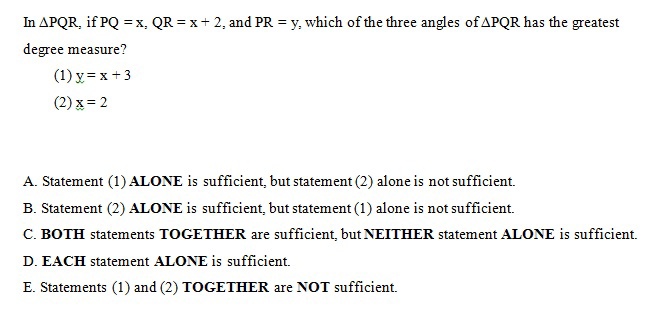
基本上,就是出了一個問題,然後給出兩個條件,如上述題目所示。與傳統的解題不同在於,DS 並不一定要把答案解出,因為 DS 的精神在於,確認資料的充分性。想想看,考 GMAT 的同學,大多希望不久的將來能升上管理階層,在籌備企劃案、或解決問題時,是否應該具備著對於資料需求的掌握能力呢?所以我個人對這個題型,是相當推崇的。好了,感想不多說,大致上,就是要問這兩個條件的充分程度。
答題流程如下圖:
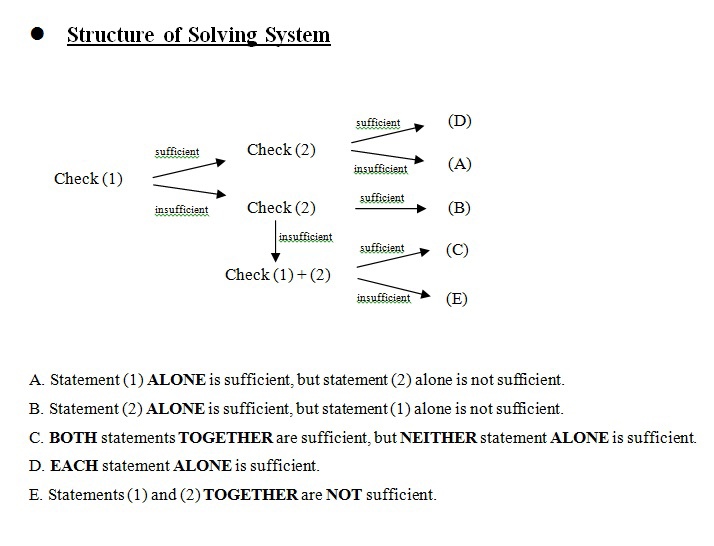
這什麼意思呢? 在此我們用自創版最簡單的題目來解釋
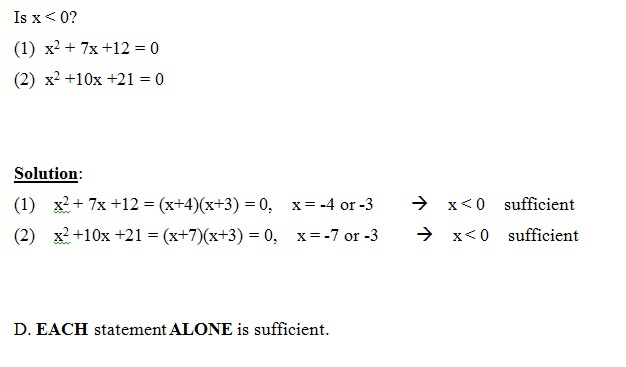
如此題,題目問 x < 0? 而兩個條件 (1) 可以得到 x = -4 or -3,雖然有兩個解,但都確認了 x < 0,所以 sufficient,回答了題目。而條件 (2) 可得 x = -7 or -3,一樣確認了 x < 0,所以也是 sufficient。以 DS 的定義,兩個條件都充分,那答案選 (D) - EACH statement ALONE is sufficient。
我們來看相似題型下一題:
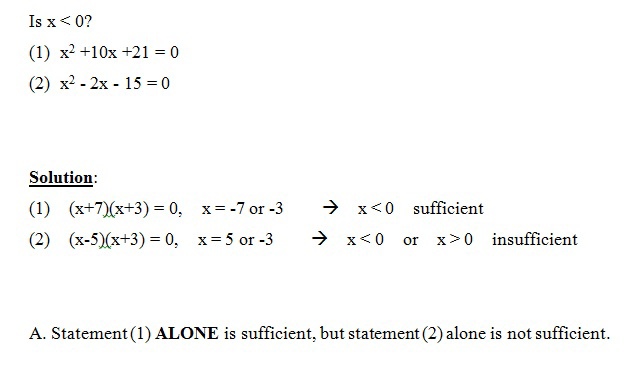
經過上一題之後,我想這題要解釋就快了。條件 (1) 不用解釋,sufficient。而條件 (2) 產生兩個解 x = 5 or -3,一個解 > 0 而另一個解 < 0,所以是 insufficient。而 DS 定義條件 (1) 充分而條件 (2) 不充分的答案為 (A) - Statement (1) ALONE is sufficient, but statement (2) alone is not sufficient.
再看相似題型下一題:
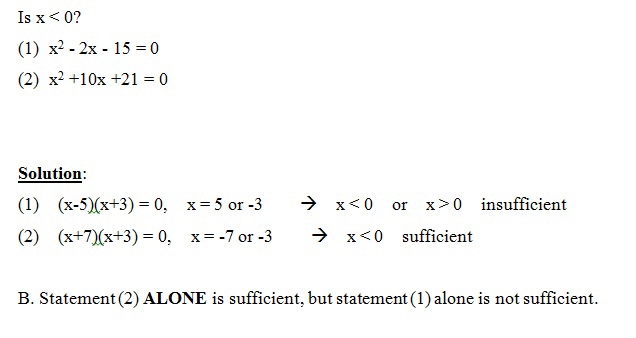
此題和上一題,兩個條件只是對調而已,所以不用多解釋。條件 (1) insufficient,而條件 (2) sufficient。而 DS 定義條件 (1) 不充分而條件 (2) 充分的答案為 (B) - Statement (2) ALONE is sufficient, but statement (1) alone is not sufficient.
繼續看相似題型:
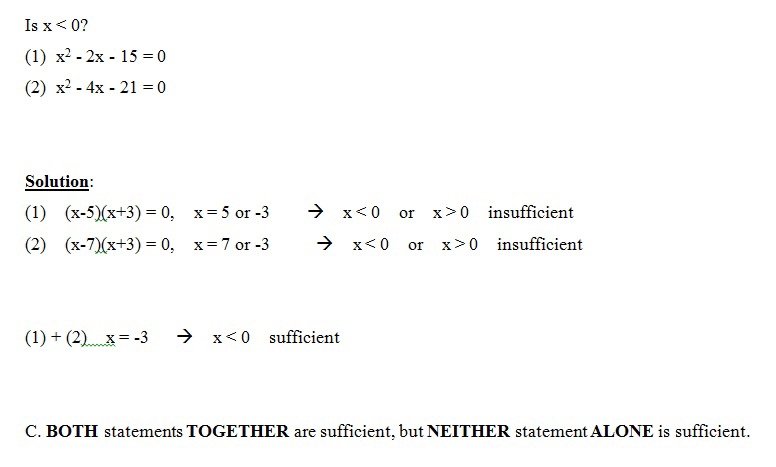
條件 (1) 和 (2) 都有正解和負解,所以分別都 insufficient。但題目不是這樣就結束了: 在兩個條件都 insufficient 的情況下,DS 會要求考生兩個條件結合一起看。這兩個條件結合,很明顯 x = -3,所以確定 x < 0,sufficient。而條件 (1) 和 (2) 合在一起看可充分回答題目的情況下,DS 定義為答案 (C) - BOTH statement TOGETHER are sufficient, but NEITHER statement ALONE is sufficient.
來看最後一題:
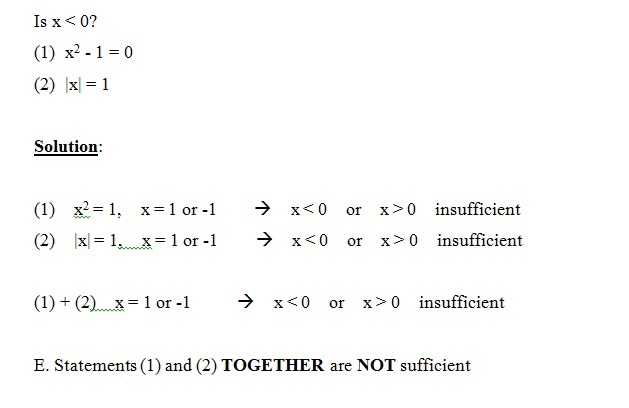
兩個條件很明顯都是 x = 1 or -1,所以即使結合,還是只能得到 x = 1 or -1 的可能性,都無法確認 x > 0 or x < 0。DS 定義兩條件結合也無法確定的情況下,答案為 (E) - Statement (1) and (2) TOGETHER are NOT sufficient.
DS 的題型大致上介紹至此,如果是初學者,請務必在最短時間內熟悉這題目及答案類型,才能盡快掌握 DS 的題型。
沒有留言:
張貼留言